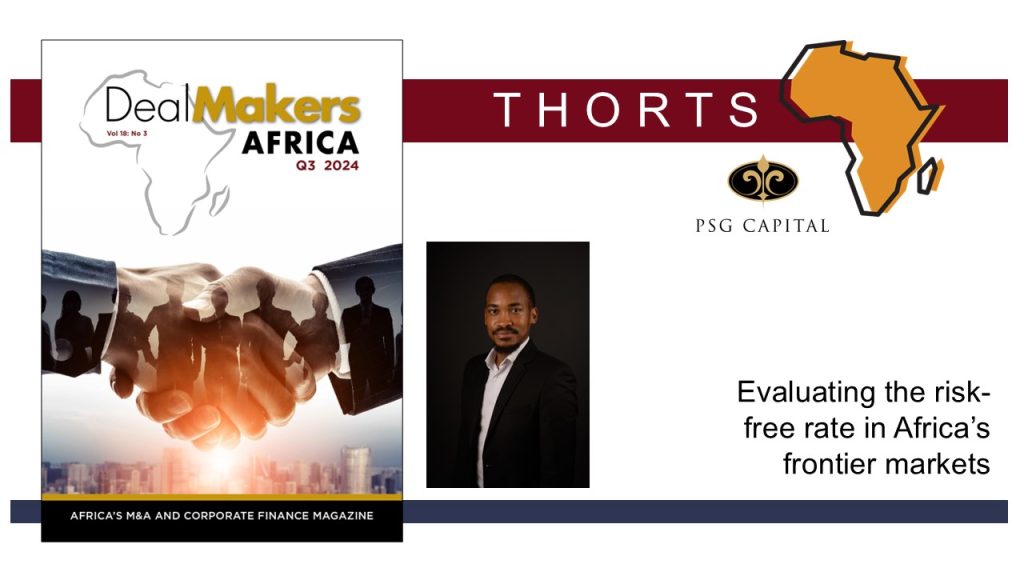The International Monetary Fund (IMF) projects that between 2024 and 2028, the gross domestic product (GDP) of African frontier markets will grow at an average rate of 4.2% per annum. Notably, countries such as Mozambique, Rwanda and Senegal are poised for substantial growth, with projected annual increases of 7.8%, 7.2% and 6.8% respectively.1 Whilst Africa is well poised for growth, investors looking to invest in these markets are often confronted by challenges, especially when considering valuations and investment decisions.
A central component in valuations and investment decisions is the risk-free rate (RFR) – typically represented by government bonds – which implies a return on investments devoid of financial loss. In current financial climates, the importance of the RFR has intensified due to increased economic volatility and geopolitical uncertainty, including significant fluctuations in inflation and interest rates. This heightened relevance of the RFR stems from its role in helping investors gauge the baseline returns on their investments against a backdrop of unpredictable market conditions. By understanding the RFR, investors can better assess the additional risks and potential returns associated with various investment opportunities.
Accordingly, it is crucial to identify the specific challenges faced in determining the RFR in African frontier markets, particularly those with less developed financial infrastructures. These markets often grapple with issues such as limited bond market liquidity and inconsistent economic data, which can complicate the accurate assessment of the RFR. By understanding these unique challenges, investors can better evaluate and account for the inherent risks when making investment decisions in these regions.
Challenges with the RFR in Africa
Reliability of government bonds: Globally, government bond yields are often used as a proxy for RFR as, in principle, governments do not default on their debt because they can print more money to pay the bond, if required to. However, in frontier markets, government bonds may be an unreliable proxy for a “risk-free” rate, due to economic instability, political unrest and market illiquidity. The low liquidity in these bond markets can lead to broad yield spreads that do not accurately reflect market conditions, and make them difficult to price. Added to this is the limited availability of data on these bonds.
Currency volatility: High currency volatility adds another layer of complexity in some African markets, especially for foreign investors. Fluctuating exchange rates can significantly impact the real value of returns due to the added forex risk, which, again, makes it difficult to price accurately.
The impact of such challenges when determining the weighted average cost of capital (WACC)
The RFR is a key building block when calculating the WACC and, ultimately, value. It encapsulates the required rate of return from all sources of capital and is intended to reflect the aggregate risk that the valuation subject is exposed to, including country risk.
The RFR anchors the calculation of the cost of equity through the Capital Asset Pricing Model (CAPM), which is integral to the WACC. The RFR serves as the baseline return required for an equity investment, before making adjustments for correlated and uncorrelated risks associated with the valuation subject in question, to adequately compensate investors for the risk assumed.
Similarly, the cost of debt, which forms the other part of the WACC, is also intrinsically linked to the RFR. The cost of debt can be described as the credit spread, which indicates the extra yield needed above the RFR, taking into account the lender’s creditworthiness and the economic environment in which the lender operates. This is typically the rate at which a bank is willing to lend to a business after taking into account the risks associated with that business.
Given the typically higher RFR in Africa, the resultant WACC is also higher, indicating a perception of greater investment risk and the higher return required to compensate for this risk, which drives valuations down. This scenario poses a significant challenge to capital inflow, as investors require higher returns to justify the increased risk associated with investing in Africa and, in some instances, are not willing to assume such elevated risks (perceived or otherwise) to achieve higher returns.
Potential solutions worth considering
Leveraging local sovereign bonds: While U.S. Treasury Bonds are often used as a base for calculating the RFR due to their stability and liquidity, they do not fully capture the inherent risks present in African frontier markets. While adjustments can be made to recalibrate U.S.Treasury yields for country and currency-specific risks, this method can oversimplify the complexities of the African market.
A more suitable approach may be to use local sovereign bonds, if available and sufficiently liquid, to provide a closer approximation of the risks specific to the region. Often, this also more accurately reflects the risk of one country relative to another, where the one may have more reliable data available on it.
Composite indices for illiquid bonds: In cases where local bonds are illiquid, a composite index that factors in country risk premiums, inflation volatility and currency risk could offer a more accurate reflection of a RFR in these markets.
Strengthening local financial markets: In the long term, developing more robust financial systems in Africa is crucial for driving liquidity and providing reliable data for benchmarking and risk assessments. This should assist in attracting investment and laying the groundwork for improved capital markets and sustained economic growth.
To accurately value companies within the current constraints of African financial markets, it is crucial to leverage existing resources effectively. A more suitable approach may be to use local sovereign bonds, if available and sufficiently liquid, to provide a closer approximation of the risks specific to the region. If these bonds are illiquid, a composite index that factors in country risk premiums, inflation volatility and currency risk — calibrated against more stable regional/local markets – could offer a more accurate reflection of risk-free capital in these environments.
In the meantime, it is essential to recognise and adapt to the limitations of the current financial infrastructure. By refining how we use these existing tools (local sovereign bonds and region-specific indices), we can better understand and navigate the complexities of African markets. This strategy not only supports more accurate company valuations, but also contributes to enhancing financial stability and fostering investor confidence, which is vital for ongoing economic development across the continent.
International Monetary Fund, 2024. World Economic Outlook, April 2024: Steady but Slow: Resilience amid Divergence. [online] Available at: https://www.imf.org/en/Publications/WEO
Sibongakonke Kheswa is a Corporate Financier | PSG Capital

This article first appeared in DealMakers AFRICA, the continent’s quarterly M&A publication.
DealMakers AFRICA is a quarterly M&A publication
www.dealmakersafrica.com



